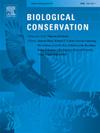Low human disturbance levels alter movement patterns and induce behavioural changes in an apex predator
IF 4.4
1区 环境科学与生态学
Q1 BIODIVERSITY CONSERVATION
引用次数: 0
Abstract
Understanding how animals adapt to human-altered landscapes is critical for conserving large carnivores. Establishing thresholds for behavioural plasticity can improve management and minimise human-carnivore conflicts. We analysed GPS data from 116 tagged jaguars (Panthera onca) across their range to investigate their spatiotemporal and behavioural responses to different levels of human disturbance. Specifically, we evaluated spatial (movement) and temporal (diurnality) responses and foraging, resting, and other behavioural response in females and males. We also examined resource selection among jaguars exposed to low, moderate, and high levels of disturbance. Our findings reveal that human activity decreases the distance jaguars travel and reduces diurnality in females and males, with these effects being stronger in highly disturbed areas. Human presence significantly reduces the time spent foraging and resting in both sexes, while other behaviours remain less affected. Jaguars consistently select highly productive and habitat-diverse areas, avoiding human-accessible regions, regardless of the disturbance level. Interestingly, jaguars in highly disturbed areas avoid regions with high livestock density, favouring human-populated areas instead. Conversely, jaguars in low and moderately disturbed areas prefer livestock-rich regions while strongly avoiding human settlements. These results highlight jaguars' behavioural plasticity and adaptive strategies as they navigate human-modified landscapes. Understanding these complex behavioural adjustments provides valuable insights for future conservation efforts, including more effective strategies to manage jaguar populations while mitigating conflicts with humans across their distribution range. This study underscores the importance of targeted conservation interventions for large carnivores in increasingly anthropised environments.
低水平的人类干扰改变了顶端捕食者的运动模式和行为变化
了解动物如何适应人类改变的环境对于保护大型食肉动物至关重要。建立行为可塑性的阈值可以改善管理并最大限度地减少人类与食肉动物的冲突。我们分析了116只被标记的美洲虎(Panthera onca)在其活动范围内的GPS数据,以研究它们对不同程度的人类干扰的时空和行为反应。具体来说,我们评估了雌性和雄性的空间(运动)和时间(昼夜性)反应以及觅食、休息和其他行为反应。我们还研究了暴露在低、中、高水平干扰下的美洲虎的资源选择。我们的研究结果表明,人类活动减少了美洲豹的旅行距离,减少了雌性和雄性美洲豹的昼夜活动,这些影响在高度干扰的地区更为强烈。人类的存在大大减少了雄性和雌性花在觅食和休息上的时间,而其他行为受到的影响较小。美洲虎总是选择高生产力和栖息地多样化的地区,避开人类可到达的地区,无论干扰程度如何。有趣的是,在高度受干扰的地区,美洲虎会避开牲畜密度高的地区,而喜欢人类居住的地区。相反,在低干扰和中度干扰地区的美洲虎更喜欢家畜丰富的地区,而强烈避开人类住区。这些结果强调了美洲豹在人类改变的环境中导航时的行为可塑性和适应策略。了解这些复杂的行为调整为未来的保护工作提供了有价值的见解,包括更有效的策略来管理美洲虎的数量,同时减少它们在分布范围内与人类的冲突。这项研究强调了在日益人类化的环境中对大型食肉动物进行有针对性的保护干预的重要性。
本文章由计算机程序翻译,如有差异,请以英文原文为准。
求助全文
约1分钟内获得全文
求助全文
来源期刊

Biological Conservation
环境科学-环境科学
CiteScore
10.20
自引率
3.40%
发文量
295
审稿时长
61 days
期刊介绍:
Biological Conservation is an international leading journal in the discipline of conservation biology. The journal publishes articles spanning a diverse range of fields that contribute to the biological, sociological, and economic dimensions of conservation and natural resource management. The primary aim of Biological Conservation is the publication of high-quality papers that advance the science and practice of conservation, or which demonstrate the application of conservation principles for natural resource management and policy. Therefore it will be of interest to a broad international readership.
 求助内容:
求助内容: 应助结果提醒方式:
应助结果提醒方式:


